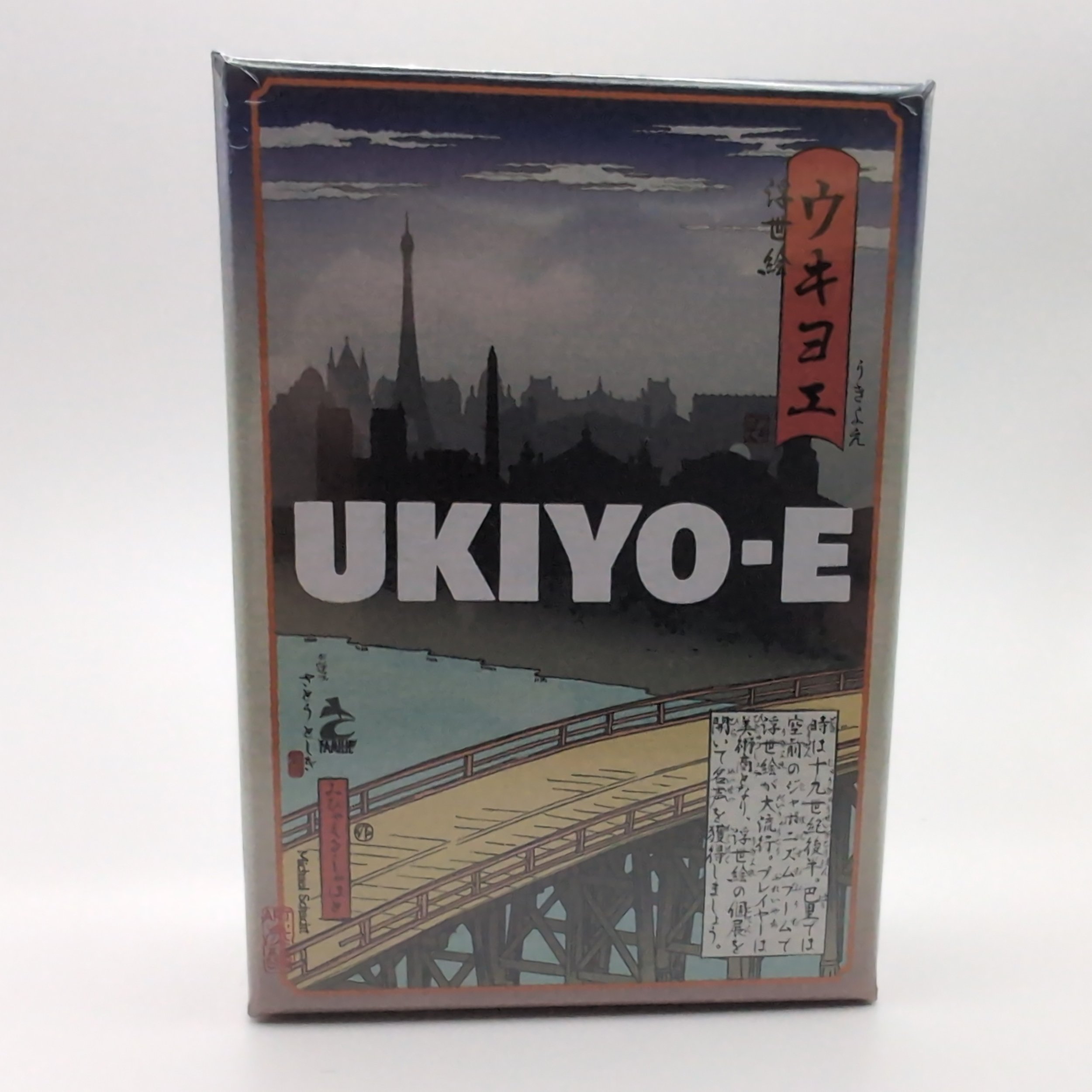 Image 1 of 1
Image 1 of 1


Ukiyo-E (IMPORT)
This game is Japanese but is language-independent and English rules are provided as PDF's if they are not within the box.
In 1867, the World's Fair in Paris sparked a craze for Japanese art and culture known as Japonisme. Art galleries specializing in Japanese ukiyo-e prints were established, and ukiyo-e became known around the world. In Ukiyo-e / ウã‚ヨエ, players take on the role of art dealers specializing in ukiyo-e and aim to hold successful solo ukiyo-e exhibitions. To lay down a set of cards, you need at least two cards if that type hasn't been played or more cards than are already on the table if it has been played, after which any cards of the same type on the table are discarded. The round ends when one player has six types of art (out of seven) or the deck runs out. Players score the lowest-valued card in each set on the table, which speeds up future rounds and can make sets more valuable. Ukiyo-e is based on Michael Schacht's 2003 game Crazy Chicken, with this new version being designed in consultation with him. 1867å¹´ã€ãƒ‘リã§é–‹å‚¬ã•ã‚ŒãŸä¸‡åšã‚’ãã£ã‹ã‘ã«ã€ã‚¸ãƒ£ãƒãƒ‹ã‚ºãƒ ã¨å‘¼ã°ã‚Œã‚‹æ—¥æœ¬ãƒ–ームãŒèµ·ã“ã‚Šã¾ã—ãŸã€‚ 浮世絵を扱ã†ç”»å»Šã‚‚è¨ç«‹ã•ã‚Œã€æ—¥æœ¬ã®æµ®ä¸–çµµãŒä¸–界的ã«æ³¨ç›®ã•ã‚Œã‚‹ã‚ˆã†ã«ãªã‚Šã¾ã—ãŸã€‚ プレイヤーã¯æµ®ä¸–絵を扱ã†ç¾Žè¡“商ã¨ãªã‚Šã€æµ®ä¸–çµµã®å€‹å±•ã‚’é–‹ã„ã¦æˆåŠŸã‚’åŽã‚ã‚‹ã“ã¨ã‚’目指ã—ã¾ã™ã€‚ 個展を開ãã“ã¨ã§å¾—点を得ã¾ã™ã€‚多ãã®å€‹å±•ã‚’é–‹ã„ã¦å¤šãã®ç‚¹æ•°ã‚’稼ãŽã¾ã—ょã†ã€‚ —Japanese description from the publisher
This game is Japanese but is language-independent and English rules are provided as PDF's if they are not within the box.
In 1867, the World's Fair in Paris sparked a craze for Japanese art and culture known as Japonisme. Art galleries specializing in Japanese ukiyo-e prints were established, and ukiyo-e became known around the world. In Ukiyo-e / ウã‚ヨエ, players take on the role of art dealers specializing in ukiyo-e and aim to hold successful solo ukiyo-e exhibitions. To lay down a set of cards, you need at least two cards if that type hasn't been played or more cards than are already on the table if it has been played, after which any cards of the same type on the table are discarded. The round ends when one player has six types of art (out of seven) or the deck runs out. Players score the lowest-valued card in each set on the table, which speeds up future rounds and can make sets more valuable. Ukiyo-e is based on Michael Schacht's 2003 game Crazy Chicken, with this new version being designed in consultation with him. 1867å¹´ã€ãƒ‘リã§é–‹å‚¬ã•ã‚ŒãŸä¸‡åšã‚’ãã£ã‹ã‘ã«ã€ã‚¸ãƒ£ãƒãƒ‹ã‚ºãƒ ã¨å‘¼ã°ã‚Œã‚‹æ—¥æœ¬ãƒ–ームãŒèµ·ã“ã‚Šã¾ã—ãŸã€‚ 浮世絵を扱ã†ç”»å»Šã‚‚è¨ç«‹ã•ã‚Œã€æ—¥æœ¬ã®æµ®ä¸–çµµãŒä¸–界的ã«æ³¨ç›®ã•ã‚Œã‚‹ã‚ˆã†ã«ãªã‚Šã¾ã—ãŸã€‚ プレイヤーã¯æµ®ä¸–絵を扱ã†ç¾Žè¡“商ã¨ãªã‚Šã€æµ®ä¸–çµµã®å€‹å±•ã‚’é–‹ã„ã¦æˆåŠŸã‚’åŽã‚ã‚‹ã“ã¨ã‚’目指ã—ã¾ã™ã€‚ 個展を開ãã“ã¨ã§å¾—点を得ã¾ã™ã€‚多ãã®å€‹å±•ã‚’é–‹ã„ã¦å¤šãã®ç‚¹æ•°ã‚’稼ãŽã¾ã—ょã†ã€‚ —Japanese description from the publisher
